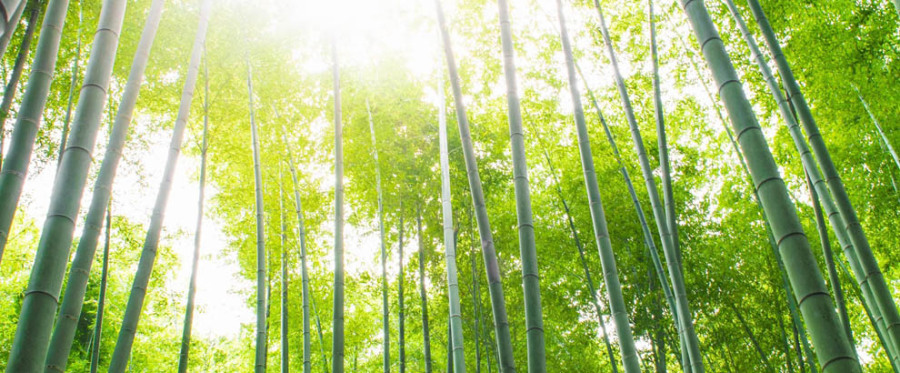Bamboo Flooring
Bamboo Flooring Pros and Cons

Choosing the right bamboo flooring
You’ve probably noticed that “green” is trending. Why? As awareness grows for the critical importance of protecting our natural resources, more and more people are willing to explore sustainable building options — including bamboo flooring. The problem, however, is that a quick internet search on bamboo flooring pros and cons can return a lot of contradictory information, leaving you with equal parts intrigue and apprehension. We want to help you shape an intelligent understanding of how bamboo is sourced, manufactured, acclimated, installed, and maintained in order to alleviate your concerns and enable you to make empowered and informed decisions when choosing your flooring.
Bamboo Origins
The story of bamboo begins deep in the heart of the Anhui province of
China. Here you can find Moso bamboo: The species most renowned for
strength, hardness, and versatility. Incredible in natural abundance,
Moso grows at a rate that far exceeds human ability to harvest it. This
remarkable resource is self-sustainable, and has been used for centuries
due to its natural structural properties. As the popularity of bamboo
rises, the costs associated with sourcing and producing it are driven
down. This has allowed Mosu to become a competitive material in today’s
building market.
The first models of bamboo flooring launched in the 1990’s, but had a
number of setbacks. The initial product wasn’t very aesthetically
pleasing, and was susceptible to denting. The good news? Since that
time, manufacturing processes have improved so much that they are now
capable of producing a product that can outperform even the hardest of
traditional hardwoods. The bad news? Bamboo manufacturing is not
currently subjected to strict quality control standards, which leaves it
vulnerable to those who want to cut corners. Differences are often hard
to determine with the naked eye, so it is crucial to understand other
ways to differentiate between low cost and quality bamboo flooring.
Bamboo Basics
Harvesting Bamboo
The quality of bamboo floors begins with the very first step: Harvesting bamboo. High grade bamboo flooring uses Moso bamboo harvested at its peak, which is around 5-7 years. Low quality floors, on the other hand, use younger bamboo, which makes it softer. Quality bamboo is thoroughly dried to 6-8% moisture, while low quality floors dry to 8-12% — cutting time to market and saving on labor, but resulting in far less durable flooring.
Bamboo Durability
A second way manufacturers can cut corners is with the amount of bamboo used in each plank. The true test? Holding samples in hand. Heavier samples indicate quality and durability, while lighter samples suggest inadequate density and planks that may bend and even break. Apart from in-hand testing, the easiest way to determine the durability of bamboo flooring is to reference its “Janka hardness rating”. This score (achieved through a process of applying thousands of pounds of pressure) helps determine how well the floor will hold up under weight, as well as its potential for scratching and denting. Many traditional hardwoods and bamboo floors will rank in the 1,000-2,000 pound range for Janka hardness, while many EEE HOUSING Bamboo floors rank upwards of 4-5,000.
Bamboo Finish
The next key factor in choosing bamboo flooring should be the amount of finish applied to the floors. Low quality manufacturers use fewer coats of aluminum oxide or other finishes, which shortens production time and lowers cost, but means more scratches and damage in the long run. High quality manufacturers utilize multiple coats to protect the floor from wear: We actually require a minimum of 10 coats of aluminum oxide finish. If you’re looking into options from various manufacturers, performing a simple scratch test on samples can be highly effective in determining the quality of the finish.
VOCs and Bamboo
A final determining factor in the quality of the floors is the type of adhesives used. Many manufacturers use inferior glues that not only affect the integrity of the product, but contain and release toxic chemicals. These chemicals can be harmful to homeowners and their families when ingested through off-gassing (a process by which installed materials slowly release carcinogens into the surrounding atmosphere). “Volatile Organic Compounds” (VOCs) like these can pose serious health risks to anyone, but are especially dangerous for young children due to the vulnerability of their developing respiratory systems. All EEE HOUSING Bamboo floors use peak-harvested Moso bamboo that is dried to 6-8% moisture, and every floor has ultra low VOCs to protect our customers and their families.
Engineered Bamboo
If you’re looking for an engineered product, a product called “engineered bamboo” has been recently brought to market in the green building community. However, just as with solid bamboo, not all engineered bamboo is equal. Low-cost engineered bamboo is made up of mostly “mystery” woods and a very thin top (wear) layer of bamboo, making it only partially eco-friendly and much less durable. Quality engineered bamboo flooring should always be composed of is a true mix of sustainable woods. It’s important to look for these characteristics when choosing an engineered product.
Bamboo in Action
Armed with a keen awareness of the importance of how a floor is manufactured, interested homeowners can move forward in choosing quality bamboo: Bamboo that is harder, more durable, flexible, versatile, and even comparable in cost to traditional hardwoods. But if all this is true, what then keeps homeowners from purchasing bamboo flooring? Some of the additional apprehension about bamboo centers around a lack of knowledge regarding application, installation, and care and maintenance.
Bamboo Installation
Bamboo can be installed across a variety of commercial and residential applications, over any subfloor, and solid bamboo can even be installed over radiant heat. In addition, while solid bamboo can be applied in almost every area, engineered bamboo products open the door to environments with extremely low or high humidity (such as below-grade rooms, like basements). Like all traditional hardwoods, bamboo flooring expands as it absorbs humidity and shrinks as the air grows drier. Unlike traditional hardwoods, bamboo has been known to expand unilaterally. While traditional hardwood planks only expand in one direction along the grain, bamboo’s lack of grain can cause expansion in two directions. The effects of this type of expansion can be minimized by allowing for expansion space along all four edges of a room, and by following a manufacturer’s pre-installation guidelines. Pre-installation guidelines often include keeping subfloors clean and level, applying vapor barriers to concrete subfloors, choosing the correct underlayment for the application, and allowing a floor to acclimate for the recommended time frame.
Bamboo Acclimation
Solid bamboo flooring usually requires a minimum of 5 days (longer for areas with extremely low or high humidity) for acclimation. Proper acclimation allows floors to adjust to the conditions in which they’ll be installed, and allows the homeowner to mix and mingle planks, accounting for natural color variation in the bamboo. After flooring has been properly acclimated, it can then be installed based on the method recommended by the manufacturer. Installation options often vary based on how the planks have been milled: Industry standard tongue and groove (T&G) is the most versatile format, allowing for gluing, nailing, and floating. Click-lock milling, while beloved by DIY-ers for its simplicity, can only be glued or floated, not nailed down. EEE HOUSING Bamboo offers flooring that can be installed using all four methods: T&G, nailing, gluing, and floating. Regardless of method preferred, it is vital to follow the manufacturer’s guidelines and choose the proper method of acclimation in order to diminish any potential for future concerns.
Refinishing Bamboo
The final question regularly posed by people considering bamboo is “Can it be refinished?” Traditional hardwoods have been around so long that homeowners have become programmed to brace themselves for the pain and anguish of a laborious refinishing process every 5-10 years. Not only is this a huge disruption in anyone’s personal life, it is a difficult, expensive, time-consuming process that creates a hyper-awareness of every small imperfection in the floor. Strand-woven, aluminum-oxide finished solid bamboo flooring breaks this cycle due to its extreme resistance to denting and scratching. While it can be refinished, it rarely (if ever) needs to be.
Bamboo Care and Maintenance
All of this prep work leads to one last consideration: How to keep bamboo flooring looking great for many years to come. Just like hardwood floors, bamboo flooring performs best when kept free of dirt and debris; when homeowners use only a vacuum designed for hard surfaces and never wet mop the floor; and when the only chemicals utilized for treatment are those recommended by the manufacturer. Light surface scratches (typically appearing as white lines) can be easily disguised using a color-matched touch-up marker. For deeper gauges, a fill stick can be used prior to the touch-up marker. Keeping the home’s relative humidity as consistent as possible and avoiding prolonged exposure of the floors to direct sunlight also helps minimize wear and discoloration.
The Bamboo Advantage
Bamboo flooring is increasing exponentially each year in its market share of the hardwood flooring industry. The rising popularity of this product has led to significant advancements, making it more durable and affordable than ever. The eco-friendly nature of bamboo ensures its ability to meet increased demand, and aesthetic improvements allow it to mimic many modern design trends (such as wide and ultra-wide plank, oil hardwax finishes, and unique, hand-scraped surface distressing). EEE HOUSING Bamboo offers high quality bamboo floors in any style and color variation that appeals to more traditional hardwood lovers, but with three times the hardness — for an eco-friendly, beautiful product that is built to last a lifetime.
4 users like this.
 EUR
EUR
